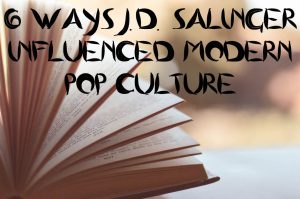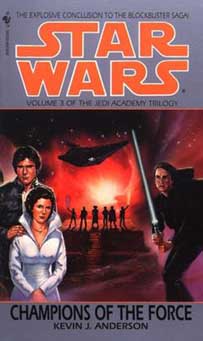I tried to be an apologist for some aspects of the first two books of Kevin J. Anderson’s “Jedi Academy Trilogy,” but that becomes harder to do with “Champions of the Force” (1994). As the plot ratchets up to a showdown between the Rebel-controlled Maw Installation, Dalla’s last Star Destroyer, a Death Star prototype helmed by yet another incompetent Imperial, the Smugglers’ Alliance fleet, and Kyp Durron in the Sun Crusher, the author’s simplistic view of the galaxy doesn’t cut it anymore.
I could nitpick this novel to death (and indeed, many fans already have in the Amazon.com threads). I could say that Lando’s business savvy is lacking; he comments that he’ll just raise prices temporarily until he pays off the high cost of Kessel spice-mining infrastructure. Um no, I think it’s more likely that supply and demand will set the spice prices. I mentioned in previous posts that Leia hiding Anakin on Anoth is strategically stupid, but in this novel, her fiscal irresponsibility is also brought to light. Anoth is fortified with cutting-edge New Republic defense technology such as a tentacle-laden robot and a computer room that can come alive and kill stormtroopers. Leia is appointed chief of state in this book, but if word of her selfish and wasteful spending got out, she might not hold that position for long.
Admittedly, these little things seem stupider when the big stuff is dumb. Some examples:
- Tol Sivren, de facto commander of the Death Star, is even more cartoonish than Daala. I suspect Anderson was aiming for parody this time, as Sivron demands committee meetings in advance of every decision on the battlefield, but the jokey approach is inappropriate considering what’s at stake. It also doesn’t make much sense that a Twi’lek and Devaronian are in positions of power within the Empire. Brainwashed scientists, sure. A genius like Thrawn, sure. But I don’t buy that the incompetent Sivron (a Twi’lek) has so many loyal human underlings in the racist Imperial Navy.
- Kyp kills millions of people — but I guess because he did it with a couple of missiles that blew up stars, it’s not the same as if he had murdered them all face-to-face? That rationale, along with the fact that most of his victims were Imperial soldiers, is the only way to explain why there aren’t any chapters with heated discussions about Kyp’s punishment under New Republic law. But remember, many of the victims — including Kyp’s own brother — were conscripted into the Imperial military. Furthermore, as explained in the movie “Clerks,” many people killed on the second Death Star were probably contracted workers; the same certainly applies to Carida, which perhaps is also populated by military members’ children.
The fact is, Kyp killed many innocents by destroying a whole planet, rather than making surgical strikes. The real-world equivalent is the U.S. government’s destruction of two Japanese cities in World War II. By the book’s end, Luke is happy to have him as a Jedi Knight, and maybe that’s a legitimate end point, but the journey shouldn’t have happened so easily. Furthermore, I’m not convinced Kyp even went to the dark side; I think he just made a poor decision to blow up Carida, and the Sun Crusher made it frighteningly possible to execute that decision. Put in a position to kill his friend Han, Kyp naturally declines; someone truly on the dark side (like Anakin Skywalker) would’ve rationalized killing everyone who stood against him.

- Lando is smitten with Mara Jade, and while I can’t blame him for that, I have to say his obsession is wildly out of character. Suave guys like Lando are good at picking up women’s cues and they play to their strengths — going after women who return their interest — rather than bumbling around like a school kid when they have no chance.
- Cilghal cures Mon Mothma by using the Force to remove all the poisonous cells from her body. At that point, Luke should have immediately declared Cilghal the Jedi Order’s grand master. The most powerful Force-users in the galaxy had searched for millennia to find ways to keep people from dying. Cilghal naturally has this power — she nails it on her first attempt, in fact — and the only cost is that she needs a long nap afterward. She is unquestionably more powerful than Luke, who was knocked into a stupor by a ghost for many chapters and had to be rescued by his students.
A lot of elements from the “Jedi Academy Trilogy” found their way into the saga, and that’s fine. I like the Jedi training center on Yavin IV, and I like a lot of the new Jedis. In faint praise to Anderson, Kyp is never as interesting in future books as he is here. The amnesiac former-mad-scientist Qwi Xux likewise is a decent character, and her relationship with Wedge has potential coming out of this trilogy. And if these books inspired Michael Stackpole to write “I, Jedi,” that’s another point in their favor.
Overall, though, if you’re embarking on an EU read (or re-read), put the “Jedi Academy Trilogy” far down on your list.
Comments
![]() Many things happen in this book, not much to care about. With such stupid villains like Durgan, Tol Sivren and Doole, Anderson really made me want that Daala returned at the end of the book, Daala! Compared to the others this pretty incompetent lady is a decent antagonist! Kip ends up being the most effective bad guy here, he kills billions and get to return to side of the good guys, bad fiction!# Posted By Eric | 9/17/13 12:18 PM
Many things happen in this book, not much to care about. With such stupid villains like Durgan, Tol Sivren and Doole, Anderson really made me want that Daala returned at the end of the book, Daala! Compared to the others this pretty incompetent lady is a decent antagonist! Kip ends up being the most effective bad guy here, he kills billions and get to return to side of the good guys, bad fiction!# Posted By Eric | 9/17/13 12:18 PM
![]() Bad fiction. That pretty much sums it up. I read these books in 1994 and don’t remember despising them. I guess my taste has improved. I vaguely remembered Kyp and the Kessel spice mines and Exar Kun and the academy. But I didn’t remember a darn thing about the last book. I guess the brain automatically filters out traumatic experiences. Enough of reading bad Star Wars. For my next flashback, I’m gonna go back to something better. I’m thinking the Bounty Hunter Wars trilogy by KW Jeter. I remember that being pretty compelling.# Posted By John Hansen | 9/17/13 2:01 PM
Bad fiction. That pretty much sums it up. I read these books in 1994 and don’t remember despising them. I guess my taste has improved. I vaguely remembered Kyp and the Kessel spice mines and Exar Kun and the academy. But I didn’t remember a darn thing about the last book. I guess the brain automatically filters out traumatic experiences. Enough of reading bad Star Wars. For my next flashback, I’m gonna go back to something better. I’m thinking the Bounty Hunter Wars trilogy by KW Jeter. I remember that being pretty compelling.# Posted By John Hansen | 9/17/13 2:01 PM

